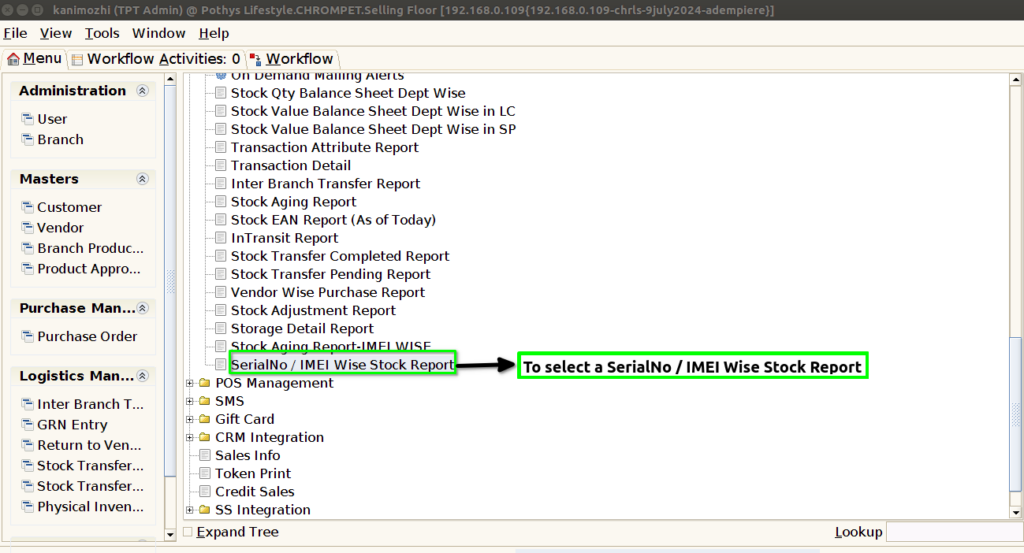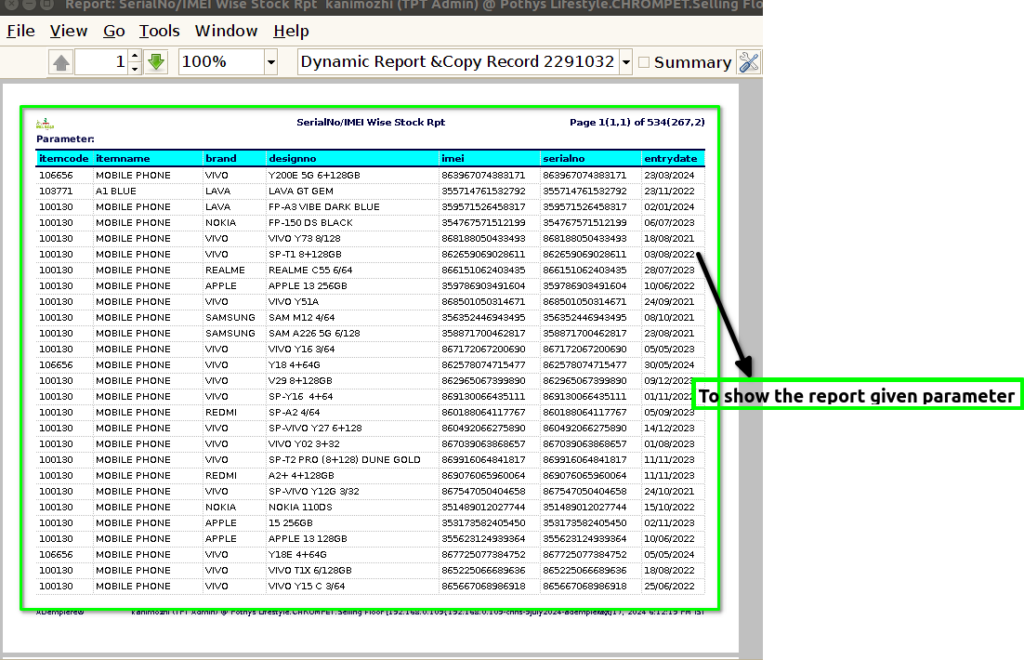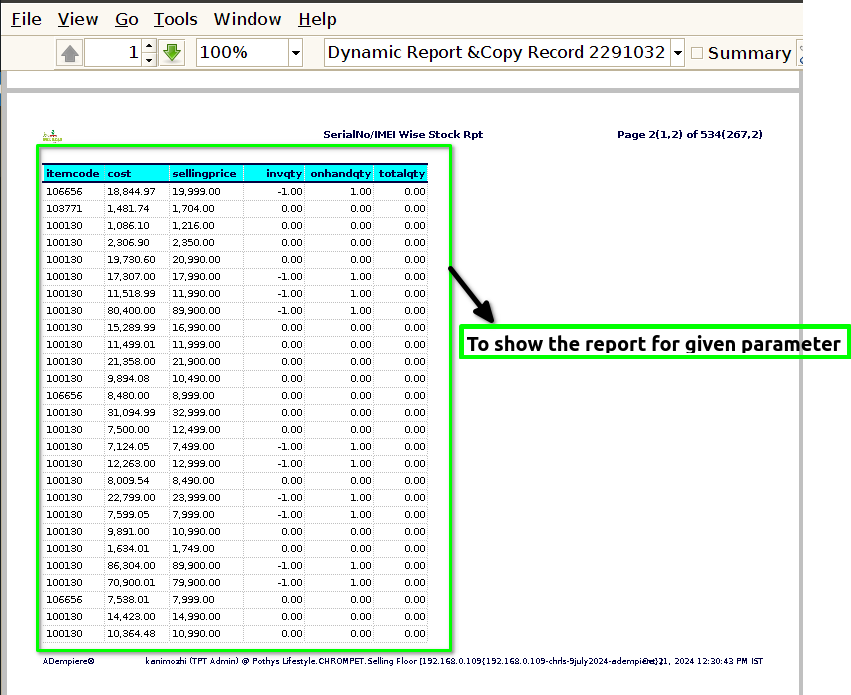TO CREATE A SERIAL NO / IMEI WISE STOCK REPORT-LS
A Serial Number (SerialNo) / IMEI Wise Stock Report is a detailed inventory report that tracks products based on their unique identifiers, such as serial numbers or IMEI (International Mobile Equipment Identity) numbers.Identification: Each device, especially in electronics and mobile phones, has a unique IMEI or serial number that distinguishes it from others.Inventory Management: Helps businesses manage stock by keeping track of individual items, making it easier to monitor sales, returns, and warranty claims.Tracking: Facilitates tracking of items in case of theft or loss, as IMEI numbers can be used to block stolen devices.Reporting: Provides insights into stock levels, sales performance, and helps in auditing.Retail management – Warehouse inventory control – Insurance and warranty processing Overall, this type of report is crucial for businesses dealing with products that require precise tracking and management.
User Access
Who Can Access
- Pothys admin
- Head cashier
- Sales Manager
- manager
What User Can Do
- View Reports
- SerialNo / IMEI Wise Stock Report.
Pre-Requisite Activities
- Dynamic Report
Business Rules
- Unique Identification- Each product must have a unique Serial Number or IMEI assigned upon receipt into inventory. Duplicate Serial Numbers or IMEIs must not be allowed in the system.
- Data Entry and Maintenance – All new stock must be entered into the system with the corresponding Serial Number or IMEI. Any changes to Serial Numbers or IMEIs must be logged with reasons for modification.
- Inventory Tracking – Each transaction (sale, return, repair) involving a device must update the inventory report to reflect the current status. Devices should be tracked through various statuses: In Stock, Sold, Returned, and In Repair.
- Reporting Frequency – Reports should be generated regularly (daily, weekly, or monthly) to monitor stock levels and identify discrepancies. Special reports may be required for high-value items or after specific transactions.
- Security and Access Control- Access to the SerialNo/IMEI report should be restricted to authorized personnel only. All actions taken on the inventory should be logged for auditing purposes.
- Warranty and Support Tracking- Maintain a record of warranty periods associated with each Serial Number/IMEI for customer service purposes. Any warranty claims must reference the appropriate Serial Number or IMEI.
- Theft and Loss Prevention – Develop a process for reporting stolen devices using their IMEI/Serial Numbers to local authorities and networks. Devices flagged as stolen should be blocked from the system and reported to relevant parties.
- Compliance and Regulation – Ensure all practices adhere to industry regulations regarding device tracking and data privacy. Maintain records as required by local laws for the retention period.9.
- Returns and Exchanges- Returned items must be verified against the original Serial Number/IMEI before processing refunds or exchanges.
- Any discrepancies must be investigated and resolved before the item can be restocked. End-of-Life Management – Establish procedures for devices that are deemed unsellable, including disposal or recycling protocols.
User Interface
STEP1: To select a SerialNo / IMEI Wise Stock Report.

STEP2: To enter a Dynamic Report field default update.

STEP3: Once to run the process to show the report based on given parameter.


STEP :4 Item code– An item code is a unique identifier assigned to a specific product or item, often used in inventory management & retail.Item codes can take various forms, such as barcodes, SKU (Stock Keeping Unit) numbers, or product IDs. Each code typically contains information about the product, such as its category, size, or color.
Item Name-An item name is the title given to a specific product or good. It typically provides clear information about what the item is, helping customers and employees identify it easily. For example, “Men’s Running Shoes,” “Organic Green Tea,” or “17-inch Laptop Bag” are all item names.
Brand-A brand is a unique identity that distinguishes a company or product from others in the market. It encompasses various elements, including the name, logo, design, messaging, and overall reputation.Brands can represent individual products (like Nike or Apple) or entire companies (like Coca-Cola or Samsung) .
Design no-A design number is a unique identifier assigned to a specific design or style of a product, often used in, manufacturing, or product development. It helps differentiate between various designs or versions of a product, making it easier to manage inventory, track sales, and communicate with suppliers or retailers. Design numbers can include alphanumeric characters . They are especially common in industries like apparel, furniture, and home goods.
IMEI-IMEI stands for International Mobile Equipment Identity. It’s a unique 15-digit number assigned to mobile devices, such as smartphones and tablets. Identification: It uniquely identifies a device on mobile networks. Security: Carriers can blacklist a device using its IMEI number if it’s reported lost or stolen, preventing it from accessing network services.Tracking: It helps in tracking devices for various purposes, including theft recovery.
Serial no-A serial number is a unique identifier assigned to an individual product or item, distinguishing it from others of the same model or type. It typically consists of a combination of letters and numbers and is used for various purposes.
Entry Date-The entry date typically refers to the date when an item, product, or record is added to a system, database, or inventory.
Cost-Cost refers to the amount of money required to acquire, produce, or maintain a product or service. It can be categorized into several types, including: Direct Costs, Indirect Costs,Fixed Costs ,Variable Costs.
Selling price-The selling price is the amount at which a product or service is offered for sale to customers. The desired profit over and above the cost, which is often expressed as a percentage. The selling price is crucial for businesses as it affects revenue, profitability, and market positioning.
Inv Qty-Inv qty” typically stands for “inventory quantity.” It refers to the number of units of a particular item that a business currently has in stock. Inventory Management,Order Fulfillment,Financial Reporting: Plays a role in calculating the value of inventory on hand for accounting purposes. Monitoring the inventory quantity allows businesses to make informed decisions about purchasing, sales, and production.
Onhand Qty-On-hand quantity refers to the actual number of units of a specific item that are physically available in inventory at a given time. Stock Management,Order Processing,Financial Reporting: Contributes to assessing the value of current assets in inventory. On-hand quantity is typically updated regularly through inventory counts and management systems to reflect any changes due to sales, returns, or new stock arrivals.
Total Qty-Total quantity” refers to the overall number of units of a specific item in inventory, encompassing all available stock, including items that are on hand, in transit, or reserved for pending orders. Inventory Management, Order Fulfillment, Replenishment Planning, Financial Analysis.
Training Videos
FAQ
SOP